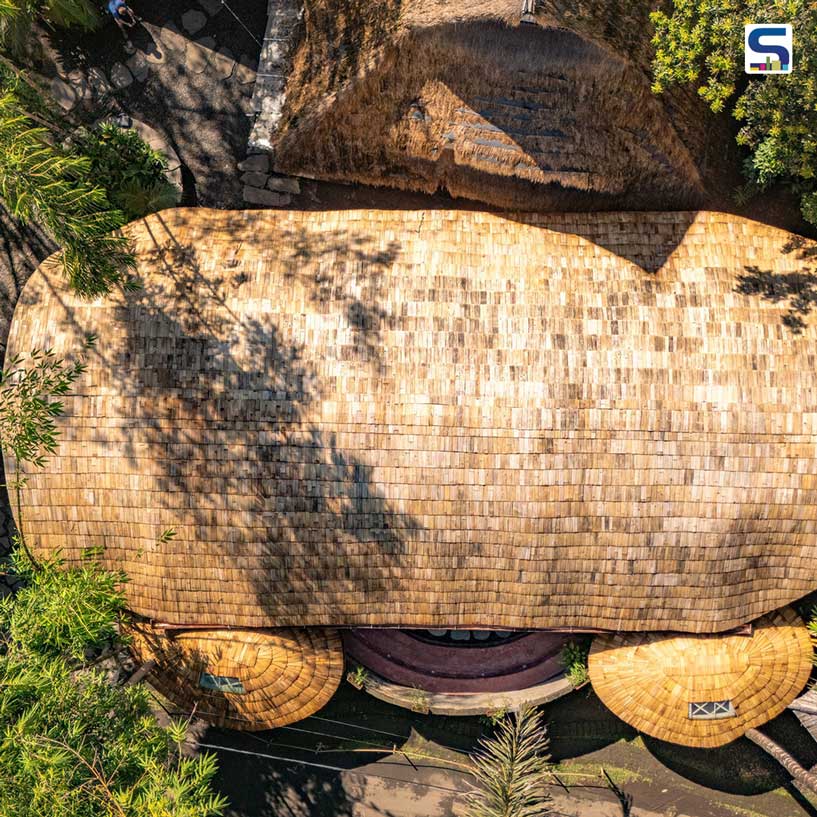
The Living Bridge Community Learning Centre at Green School Bali is a unique, student-led architectural project that evolved from the school’s progressive Jalan Jalan programme, which is an experiential learning initiative inspired by the Indonesian concept of taking a journey. Initially launched as an educational design exercise under the guidance of architect and mentor Jonathan Mizzi, the project has matured into a fully realised structure that now serves as a vibrant coworking space, learning hub and event venue at the heart of the school’s campus. Know how the Living Bridge stands as a symbol of what can be achieved when students, educators and professionals co-create with shared purpose and respect for the environment on SURFACES REPORTER (SR).
_11zon.jpg)
Over 300 pieces of locally harvested bamboo, shaped using advanced heat-bending methods in collaboration with local experts Bamboo Pure, form the structural core.
Leaning by Building
Spearheaded by Mizzi and supported by Mizzi Studio, the initiative began with students aged 15 to 18 engaging in the full arc of design, right from conceptual sketching to construction. Named The Living Bridge, the centre had been envisioned as a welcoming smile at the school’s entrance, which resonates with a gateway that would connect, celebrate and activate the wider Green School community. The idea was to create a space that brings together students, parents, teachers and alumni in a flexible and collaborative environment, one that remains true to the school’s core philosophy of sustainability and hands-on community-driven learning.
_11zon.jpg)
These arches support a gracefully cantilevered roof clad in Pelupuh, which are flattened bamboo shingles typical of traditional Indonesian architecture.
Occupying a site formerly used as a recycling centre, the Living Bridge project tackled the challenge of designing a structure that complements Green School’s indoor-outdoor learning ethos. It was built during the academic year, with the school remaining operational throughout the construction period. Students not only participated in the design but also in the building and fundraising processes, making it an integral part of their curriculum. The construction involved weekly remote consultations between Mizzi, parents, the onsite team and students, ensuring seamless collaboration during both the tendering and construction stages.
_11zon.jpg)
The materials palette includes a range of regenerative and recycled products such as terrazzo made from crushed glass, bricks formed from industrial waste ash, carbon-sequestering lime plaster and mycelium-based acoustic panels.
Sustainability and Creativity
Sustainability and innovation are deeply embedded in the materials and techniques used to build the Living Bridge. Over 300 pieces of locally harvested bamboo, shaped using advanced heat-bending methods in collaboration with local experts Bamboo Pure, form the structural core. These arches support a gracefully cantilevered roof clad in Pelupuh, which are flattened bamboo shingles typical of traditional Indonesian architecture. Eight heat-bent pillars form the building’s skeletal frame, anchoring a design that is both structurally sound and visually striking.
The materials palette includes a range of regenerative and recycled products such as terrazzo made from crushed glass, bricks formed from industrial waste ash, carbon-sequestering lime plaster and mycelium-based acoustic panels. Even the flooring, developed by local material company Altarize, features a blend of lime, clay, waste plant fibre and recycled glass, ensuring both durability and environmental sensitivity.
_11zon.jpg)
Eight heat-bent pillars form the building’s skeletal frame, anchoring a design that is both structurally sound and visually striking.
The interior layout is designed for maximum versatility. Circular furniture arrangements foster interaction and group learning, while enclosed booths cater to those seeking quieter, more focused spaces. Interactive digital pillars, designed by students, aim to connect the current school body with its alumni and parent mentors. Student-crafted furniture from recycled site materials further reinforces the ethos of sustainability through reuse.
_11zon.jpg)
The idea was to create a space that brings together students, parents, teachers and alumni in a flexible and collaborative environment, one that remains true to the school’s core philosophy of sustainability and hands-on community-driven learning.
Similarly, a doorless, bamboo-clad academic hub, TAPMI’s Sustainability Centre in Manipal ingeniously blends campus and community. Designed by The Purple Ink Studio, it features open-air spaces, solar energy, water recycling, and chhatri-inspired parasols that create a vibrant, inclusive space that fosters sustainability, local craftsmanship and seamless interaction between students and the wider community
Project details
Location: Green School Bali
Client: The Green School Bali, Education In Motion
Status: Complete
Key materials: Heat-Bent Bamboo
Key services: Design, visualisation, tutoring
Collaborators: Bamboo Pure, Altarize Materials
Photographs: Eden Rice/Mizzi Studio